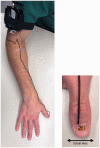Quantifying performance metrics of cervical spine mobilization for improved education and clinical outcomes: Early experience with a novel wearable device
- PMID: 31191931
- PMCID: PMC6453047
- DOI: 10.1177/2055668318765396
Quantifying performance metrics of cervical spine mobilization for improved education and clinical outcomes: Early experience with a novel wearable device
Abstract
Introduction: Evaluation of manual skills training for spinal rehabilitation has been stagnant for 40 years. Observation and mimicry are coupled with feedback from "expert" observers to train and evaluate learners, relying on rater experience to discern speed and force. Spinal manipulation is a controlled act under the Regulated Health Professions Act (1991) as it is not without risk. The discordance between current methods for evaluating proficiency and the potential risks of inadequate application is a critical gap.
Methods: This work reports a novel wearable device that measures finger forces via microstrain bending of the physiotherapist's nail. The device leaves the tactile finger pad unobstructed and does not interfere with treatment application. Five expert-level physiotherapists performed a standard postero-anteriorly directed spinal segmental mobilization treatment for 1 min at 1-1.5 Hz rhythm.
Results: The device successfully measured all treatment forces (0.2-27.3 N). Physiotherapists applied a maximum force rate of 0.03 ± 0.01 N/s with a rhythm of 1.76 ± 0.38 Hz. In 15 trials, there were no device failures. The device was easily applied and removed, and physiotherapists were able to walk about and interact normally with patients.
Conclusions: These results indicate that this technology can be integrated into a skills training program to provide quantitative feedback for objective assessments.
Keywords: Manual skills training; rehabilitation; sensors/sensor applications; spinal rehabilitation; tactile sensors.
Conflict of interest statement
The author(s) declared no potential conflicts of interest with respect to the research, authorship, and/or publication of this article.
Figures



References
-
- Ernst E. Deaths after chiropractic: a review of published cases. Int J Clin Pract 2010; 64: 1162–1165. - PubMed
-
- Senelick RC. Chiropractic manipulation can cause a stroke. Huffington Post 2012.
-
- Press WF. Group wants provincial ban on some neck manipulation by chiropractors, Winnipeg Free Press, Winnipeg Canada, 2012.
-
- Carlesso LC, Gross AR, Santaguida PL, et al. Adverse events associated with the use of cervical manipulation and mobilization for the treatment of neck pain in adults: a systematic review. Man Ther 2010; 15: 434–444. - PubMed
LinkOut - more resources
Full Text Sources
Miscellaneous

